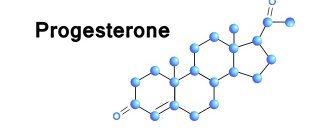Progesterone is a steroid hormone. It is produced in organisms of both sexes in the ovaries and testicles, respectively. A small amount of it is produced by the adrenal glands. Its function is mainly related to the genital area.
It is often referred to as a pregnancy hormone: it prepares the endometrium of the uterus for the implantation of an egg after its fertilization and the subsequent bearing of a child.
What is the hormone progesterone produced in women responsible for?
- It helps the egg to strengthen in the uterine cavity after fertilization;
- Stops menstruation after conception;
- Does not allow the muscles of the uterus to contract, stimulates its growth;
- Increases sebum production;
- Increases blood pressure.
Progesterone concept
Progesterone is a substance that is part of the group of gestagens. It is found in the body of both sexes. It is of particular importance in a girl’s body, due to the fact that it is responsible for her reproductive function.
It begins to be produced in the 2nd phase of menstruation (after ovulation, but before the appearance of critical days). Its production occurs in the corpus luteum. It is a non-permanent gland that arises in the follicle. Throughout life, at the onset of critical days, a follicle is formed in the female body, allowing the egg to travel to the uterus through the fallopian tube at a certain period of time.
The hormone affects the tone of the uterus, preventing it from contracting (menstruation does not occur, fertilization occurs). If the amount of the hormone is below normal, then uterine spasm occurs, menstruation occurs, and pregnancy is not observed.
Therefore, in order for fertilization to occur and to maintain gestation in the early stages, the level of progesterone must be high. Under normal conditions, it is produced in the required volumes and supports the process of gestation until the 16th week (after this function is performed by the formed placenta).
Features of synthesis
Progesterone generation begins in the second phase of the cycle. The process of hormone synthesis directly depends on the corpus luteum, which can only form after the follicle ruptures.
If there is a lack of estrogen in a woman’s body, then the egg will not be released and, accordingly, the generation of progesterone will not begin.
In the luteal second phase
After this stage occurs, a dense layer of the endometrium begins to form. It is necessary for fixation of the fertilized egg. A lack of progesterone will make pregnancy impossible, since the fertilized egg will not be able to attach.
Attention! If there is not enough hormone in this phase, then the reason lies in the dysfunction of the corpus luteum.
Functions of progesterone
Among the main functions of the hormone progesterone are:
- Influence on the immune system to prevent embryo rejection;
- Creates cervical mucus, which acts as protection during pregnancy from the pathological effects of the external environment (germs and bacteria);
- Stimulation of labor;
- Impact on milk formation during lactation;
- Normalization of blood pressure
- Reducing excessive blood viscosity;
- Stabilization of blood glucose levels, etc.
Diet
The clinical manifestation of the disease is sudden weight gain. Therefore, dietary nutrition plays an important role in the treatment and restoration of hormonal levels . It is necessary to strictly limit the consumption of protein foods, which slightly increase the hormone.
Protein foods include:
- cottage cheese;
- milk;
- cheese;
- beef meat;
- seeds;
- legumes;
- nuts;
- flour products;
- rice.
Eating these foods will not immediately increase progesterone levels, as they do not directly affect progesterone production. But there is an indirect effect on hormonal synthesis.
Foods rich in protein and cholesterol activate processes in the body that stimulate hormonal increases. In this case, it is advisable to consume carbohydrates (peas, potatoes, carrots, parsley, beets, onions).
Fruits and dried fruits are also beneficial for hyperprogesteronemia . They contain many vitamins and nutrients. Decoctions of red rowan, mint, and cloves are effective in restoring hormonal levels.
During pregnancy, it is not necessary to adhere to such a diet , except for the strict recommendations of a doctor who knows the clinical picture of the expectant mother.
But diet therapy is an auxiliary means of correcting the disease. This does not in any way replace the main treatment, which should play a major role in normalizing hormonal levels.
Main causes of low progesterone
The corpus luteum develops within one menstrual cycle. Its appearance depends on the functioning of this gland. Luteinizing hormone influences the formation of progesterone. In other words, changes in the typical functioning of the body leads to hormonal imbalance, and the production of progesterone will be reduced.
Among the primary factors in low progesterone concentrations are usually called:
• Absence of the corpus luteum; • Low level of luteinizing hormone; • Underdevelopment of the placenta; • Problems in the menstrual cycle; • Infectious disease of the genital organs; • Uterine bleeding; • Long-term use of hormonal drugs; • High level of physical activity; • Disturbances in the functioning of the endocrine system; • Salpingoophoritis; • Amenorrhea.
Maintenance during pregnancy and after childbirth
During gestation, progesterone physiologically increases , starting in the first trimester of pregnancy. This is a normal phenomenon, which indicates that there are no intrauterine abnormalities.
Hyperprogesteronemia gradually increases according to the established time limits.
If in the 1st trimester progesterone levels can reach 470 nmol/l, then in the 3rd trimester the levels increase to 770 nmol/l. This is not a pathology, but the maturation of the placenta , which produces progesterone.
Low numbers are much more dangerous , especially at the beginning of pregnancy, as this can lead to miscarriage. However, extremely significant hyperprogesteronemia during pregnancy is also not the norm.
This indicates pathological changes in the placenta, which can increase the size of the uterus or cause complications for the fetus (hydatidiform mole). This condition can be corrected medicinally with drugs; for this you need to immediately consult a doctor.
No one excludes the individual characteristics of the body, since hormonal levels during pregnancy are constantly changing. It is not at all necessary that all indicators will exactly correspond to the reference values.
Characteristics of the main signs of progesterone deficiency
When certain signs occur in the female body, an experienced gynecologist can conclude that there is a lack of progesterone.
• It is necessary to focus on the following manifestations in the body: • Quite frequent delays in menstruation; • Heavy discharge; • The appearance of blood outside of critical days; • Problems with conception; • Natural interruption of the gestation state at the initial stage.
A small concentration of progesterone has an impact on the general condition of the female body, creating discomfort (increase in body temperature, mood changes, weakness, vaginal dryness, weight gain, migraine, feeling of bloating and others). The presented symptoms appear two weeks before the onset of menstruation and cease after it.
How to determine progesterone deficiency
Lack of progesterone is determined by a special blood test. Next, specialists conduct a more in-depth examination, which consists of identifying the cause of the pathological condition. For these purposes the following is prescribed:
- Ultrasound;
- blood biochemistry;
- tests for other hormones;
- echo examination of the thyroid gland;
- computed tomography or MRI;
- diagnostic laparoscopy, etc.
Symptoms of low progesterone
Impact of the luteal phase
Due to the fact that the level of the hormone is influenced by the luteal phase, in case of its deficiency, the amount of progesterone decreases. Among the factors of this condition may be ovarian pathology.
Among the diseases that lead to insufficient luteal phase are:
1. Polycystic ovary syndrome. This disease is due to the fact that the follicle is not released and remains in the form of a cyst. 2. Resistant ovarian syndrome is a decrease in the sensitivity of the organ to the influence of hypothalamic hormones. The ovaries stop responding to the effects of follicle-stimulating and luteinizing hormones, and therefore the egg does not mature. 3. Ovarian hyperinhibition syndrome is formed under the influence of medications and other factors, the action of which slows down the action of the pituitary gland. 4. Premature exhaustion syndrome refers to the premature occurrence of menopause (due to stress, the influence of medications, etc.).
Organic causes are associated with the occurrence of endometriosis, uterine cancer, polyps, etc.
Impact of the thyroid gland
Insufficient levels of hormones produced by the thyroid gland affect hormonal levels and the possibility of fertilization. Under the influence of substances, the liver produces a protein that allows the removal of testosterone and estradiol.
In a situation where little protein is produced, testosterone increases in the bloodstream, suppressing the ovulation process. Consequently, the corpus luteum does not appear, and progesterone is at a minimum level.
If there are problems with the thyroid gland, girls may be diagnosed with infertility. In a situation in which pregnancy occurs, it is accompanied by a high risk of miscarriage or congenital pathology of the thyroid gland in the fetus.
Activities of the hypothalamus and pituitary gland
Failure of the hypothalamus and pituitary gland leads to disruption of hormonal secretion. The disease pituitary hypogonadism is considered one of the most difficult in these areas of the brain, which creates conditions for miscarriage due to insufficient levels of the hormone progesterone.
The role of the placenta
From the 16th week of pregnancy, the amount of progesterone decreases, and the placenta takes over the function of ensuring a favorable course of pregnancy.
If there are problems in its formation, as well as with premature aging in the initial stages, it leads to an early decrease in the hormone.
Other factors that affect the amount of progesterone in a girl’s body are poor nutrition, an incorrect combination of the level of fats, proteins and carbohydrates in food. A decrease in the amount of progesterone is affected by a lack of vitamins, stress, high physical activity, etc.
Pregnancy and low progesterone
The state of bearing a child with low progesterone levels is possible, but depends on the degree of its decrease. In such cases, conception may occur, but if there is a lack of hormone, spontaneous miscarriage occurs. In the last trimester, if the hormone level is insufficient, the baby is carried to term.
Treatment
To adjust progesterone levels, patients are prescribed a course of drug therapy. If the reason for fluctuations in its concentration is associated with tumor processes, then an oncologist should treat this category of patients.
In the case when the cause of the pathological condition lies in thyroid dysfunction, a treatment regimen is developed by an endocrinologist.
Important! When hyperprolactinemia is detected, women are prescribed Bromocriptine and Cabergoline.
What to do
If there is a lack of progesterone, patients must, in addition to drug therapy, adjust their diet. They are also recommended to give the body moderate exercise every day, spend more time in the fresh air, and eliminate stressful situations from life.
When planning a pregnancy
If a woman wants to become a mother soon, she will have to take hormone-containing medications according to an individually developed doctor regimen. Often, in case of hormone deficiency, Utrozhestan, Duphaston, Ingesta, etc. are prescribed.
Duphaston
This medication is synthetic progesterone. If there is insufficiency of the corpus luteum, then the drug should be taken twice a day, 10 mg, from the 11th to the 25th day of the cycle.
To prevent spontaneous abortion, you should take 10 mg tablets every 8 hours until the threat is eliminated.
Oxyprogesterone
This drug is in the form of an oil solution intended for intramuscular administration. It is prescribed to patients with a lack of progesterone, amenorrhea, or threatened miscarriage.
To induce menstruation, 3-5 injections are enough, and a week after completion of therapy, menstrual flow will appear.
Normalization of nutrition
Women can correct hormone deficiency by changing their diet and menu. The diet should contain foods containing large quantities of zinc and selenium. Patients over 40 years of age should adhere to a vegetarian menu.
Attention! For this category of patients with a lack of progesterone, experts recommend taking fish oil and B vitamins.
Methods for detecting low progesterone levels
In situations where a girl has irregularities in the menstrual cycle, has a history of spontaneous abortions, as well as threats of termination of pregnancy, she needs to pass a certain hormone test. If the girl is not pregnant, this test is carried out on days 22-23 of the cycle (with a standard duration of 28 days).
The amount of progesterone should be maximum. If the cycle is more or less standard, the time for the test is determined by the gynecologist. During pregnancy, a progesterone test is performed at any time.
When a girl experiences a delay in her period, the study is carried out in conjunction with the detection of other hormones (estrogen, prolactin, hCG, cortisol and others).
Blood is taken from a vein on an empty stomach . 24 hours before taking the tests, you should exclude fatty and fried foods and alcoholic beverages from your diet.
In order to determine the causes of low progesterone, other tests are prescribed:
• Based on the results of a biochemical blood test, one should judge the general condition of the body, exclude or confirm liver pathologies; • Tests for the level of thyroid hormones (determination of hypothyroidism); • Ultrasound diagnosis of the pelvic organs reflects the condition of the ovaries, indicating the presence of a follicle and corpus luteum in them; • Abdominal ultrasound is performed to identify problems with the liver and adrenal glands; • MRI and CT of the brain are necessary to determine whether there is a tumor in the pituitary gland that affects the amount of progesterone formed and other methods.
Diagnostic methods
A lack of progesterone can be detected through laboratory tests of biological material, in this case blood.
Women to whom doctors have given a referral for examination should undergo it on the 22nd or 23rd day of the cycle, the average duration of which is 28 days. It is during this period that the concentration of the hormone in the blood will be maximum.
Low progesterone in men
Due to the fact that this hormone is present in both the female and male body, men may experience a decrease in progesterone. Factors that can cause low progesterone levels in men include:
• Erectile dysfunction; • Inflammation in the genital area (prostatitis, orchitis); • Prostate cancer; • Pathologies in kidney function, etc.
In addition, the amount of progesterone in the male body is affected by eating junk food, taking penicillin antibiotics, and high physical activity.
Why are high values dangerous?
Long-term hormonal imbalances can cause significant harm. Increased progesterone is no exception.
Hyperprogesteronemia causes complications and other diseases , which are then quite difficult to treat. The most dangerous are tumors and cysts of the pelvic organs.
With such an advanced hormonal disorder, an ovarian corpus luteum cyst is usually diagnosed.
This is a benign neoplasm that is formed as a result of the accumulation of fluid in the ovarian tissue. The cyst begins to intensively produce the hormone, so its high concentration is found in the blood serum.
This pathology can be successfully treated with drugs , and in rare cases, surgery is possible. In the worst case scenario, it may rupture, but this is an uncommon occurrence in clinical practice.
Dangerous consequences are malignant tumors, but they occur very rarely. These include lipid cell neoplasms or chorionepithelioma, which forms during pregnancy or after childbirth.
However, such serious pathologies account for only 1-3% of all gynecological diseases.
Hyperprogesteronemia can also manifest itself in the urological field. Adrenal dysfunction or kidney failure are possible consequences of late consultation with a doctor. Each person has an individual body, so it is impossible to say exactly what the consequences will be.
The mechanism of occurrence of some diseases has not yet been studied. In advanced cases of hyperprogesteronemia, the following clinical manifestations are possible:
- ovarian corpus luteum cyst;
- malignant and benign tumors;
- diseases of the adrenal glands, including oncology;
- renal failure;
- infertility;
- cirrhosis of the liver;
- obesity.
All of these diseases can be treated with medication and surgery. But the main thing for the patient is not to start the pathological process. Early consultation with a doctor will avoid many complications and symptoms.
Folk remedies
The suggested remedies for lowering progesterone are listed for informational purposes. They can be used as an adjunct to a doctor's prescription, but not as a primary treatment.
Popular recipes for symptoms of excess progesterone:
- Mint and rowan tincture. For the tincture, use rowan flowers and mint leaves, which can be dried. 1 tbsp. l. plants are poured with 1 glass of boiling water. Within 30 min. The remedy is infused. 1 glass is taken in 3 equal portions per day, after meals.
- Rowan tincture. 2 tbsp. l. berries (frozen or fresh) pour 0.5 liters of boiling water. When the drink has cooled, drink it within 1 hour.
- Carrot seeds. For 40 gr. seeds you will need 3 cups of hot water, preferably just boiled. The product is infused in a dark place for 24 hours. One serving is taken during the day, 1 glass.
- Dried cloves. For 10 gr. spices use 1 cup boiling water. Leave for 30 minutes. Then the infusion is filtered and drunk in equal portions 4 times a day.
- Rowan flowers, 1st method. Two teaspoons of flowers are poured into 1.5 cups of boiling water. Leave for 1 hour. Strain and take during the day in 3 equal portions.
- Rowan flowers, 2nd method. As in the previous recipe, you will need 2 teaspoons of flowers. Place them in a saucepan and add 1 glass of water. Bring to a boil, simmer for 15 minutes. Take the decoction 1 day in advance, dividing it into 2-3 servings.
The course of therapy with folk remedies is longer than medication. Also, there is no guarantee that it will help if progesterone is high. Women who prefer traditional methods of treatment focus on their own well-being, determining when it is time to stop taking tinctures or decoctions. Unfortunately, this method is ineffective. Expecting an improvement in well-being, a woman may encounter a placebo. In normal treatment, the health status is assessed by repeat blood tests.
What factors increase?
Symptoms and causes of high progesterone in women should be discussed with your doctor. There are several conditions or diseases in which progesterone levels may increase, namely:
If the doctor discovers hyperprogesteronomia, then additional research is necessary to help make an accurate diagnosis. In frequent cases, increased levels of the hormone indicate that pregnancy has occurred. But if a woman is sure of the opposite, then the doctor must find the reason for the increase in the hormone. You should be aware that a hormonal or antitumor drug can cause an increase in progesterone. After their cancellation, hormonal levels are often restored. Based on the diagnostic results obtained, the attending physician prescribes a comprehensive treatment that will help cure the disease.











